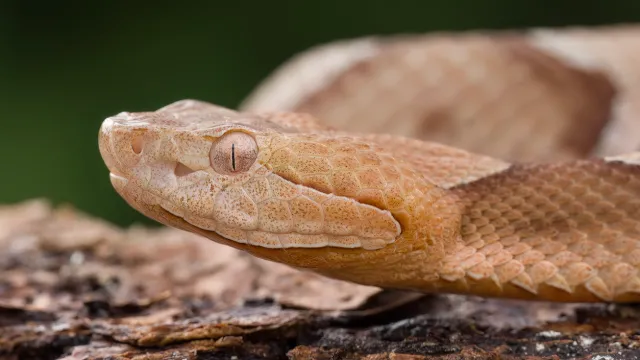Officials Issue New Warning Amid Sudden Surge in Snake Bites—Record Year Predicted

While most people know there are risks associated with enjoying the outdoors, the thought of a run-in with a venomous snake can still feel like a remote possibility. But as spring begins and we head back outside, the chances of encountering a reptile on the hiking trail or even on your property tend to go up. And now, officials have issued a new alert warning the public after a sudden surge in snake bites.
RELATED: 6 Top Signs There Are Snakes in Your Yard.
As of March 19, health and wildlife authorities in Georgia announced that there have been five reported snake bites in the state so far in the past week. They specified that in every case, a venomous copperhead was involved—and predicted it could be a record year for such incidents.
“One involved a two-year-old who was in their yard, playing and required anti-venom. So it was a pretty serious case,” Gaylord Lopez, executive director of the Georgia Poison Center, told local Atlanta ABC affiliate WSB-TV. “That required transfer to one of the local here children’s hospitals.”
He also noted that accidental encounters could happen because of the surprising locations where they can be found.
“We warn people whether they’re inside or outside,” Lopez told the news outlet. “We’ve had a couple of snake bites indoors, in work sheds, and whatnot. We’ve had the other couple, two or three, being outdoors.”
The resurgence of snake season also poses a complicated problem for pets. While they’re rarely fatal for humans, a small cat or dog can have as high as a 30 percent mortality rate when bitten, Jason Clark, an expert with Southeastern Reptile Rescue, told WSB-TV.
According to recent research, the uptick might be related to weather conditions. A study published last July in the journal American Geophysical Union looked at data from Georgia hospitals from 2014 through 2020, during which 3,908 patients were admitted for snake bites.
After comparing visits’ dates with weather data, the researchers found that for every one degree Celsius increase in temperature, there was a 6 percent increase in snake bites. And while there were more incidents overall during the summer, the spring saw the closest association between warmer days and an increase in bites.
RELATED: First Rattlesnake Bite of the Year Prompts Urgent New Warnings.
Officials urged the public to stay aware of their surroundings while outdoors—especially anywhere that’s a likely snake habitat—and to keep their distance from any reptiles they spot. Those who are bitten should also take the proper first aid steps and seek medical attention immediately.
“No putting ice on the site, no using a tourniquet, no using medication and alcohol,” Lopez told WSB-TV. “No sucking it out like in the old Western movies we used to see.”
And while it might seem easy to villainize the reptiles, it’s just as important to remember how vital they are to the ecosystem—and that we’re sharing their habitat.
“The key factor to reducing negative encounters is education,” Lawrence Wilson, a herpetologist at Emory University and co-author of the study, said in a statement. “Let people know what habitats snakes favor, such as places with dense groundcover, and they can be wary of such habitats. Snakes and people can live compatibly, even venomous snakes, as long as we respect and understand their habitats and needs.”